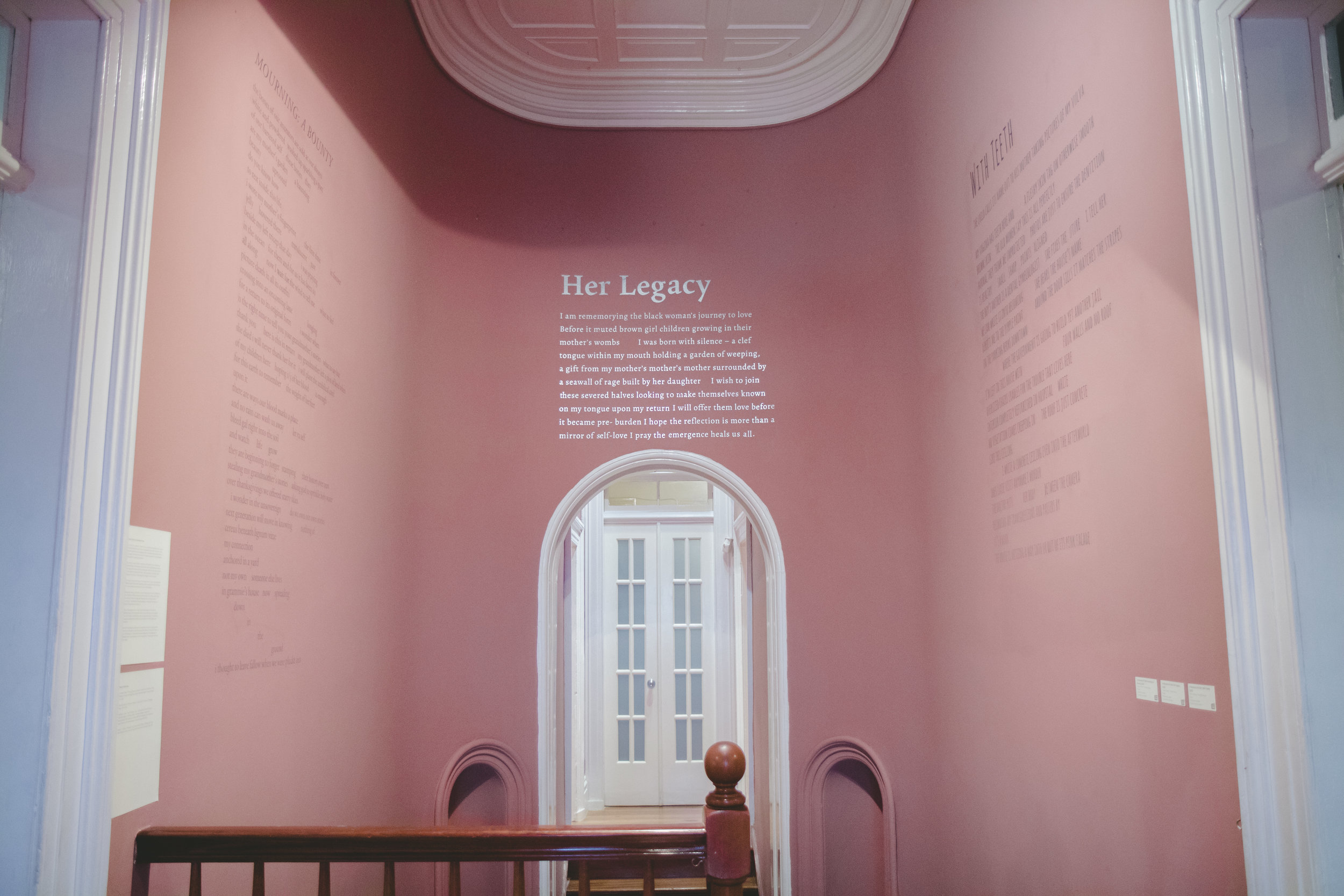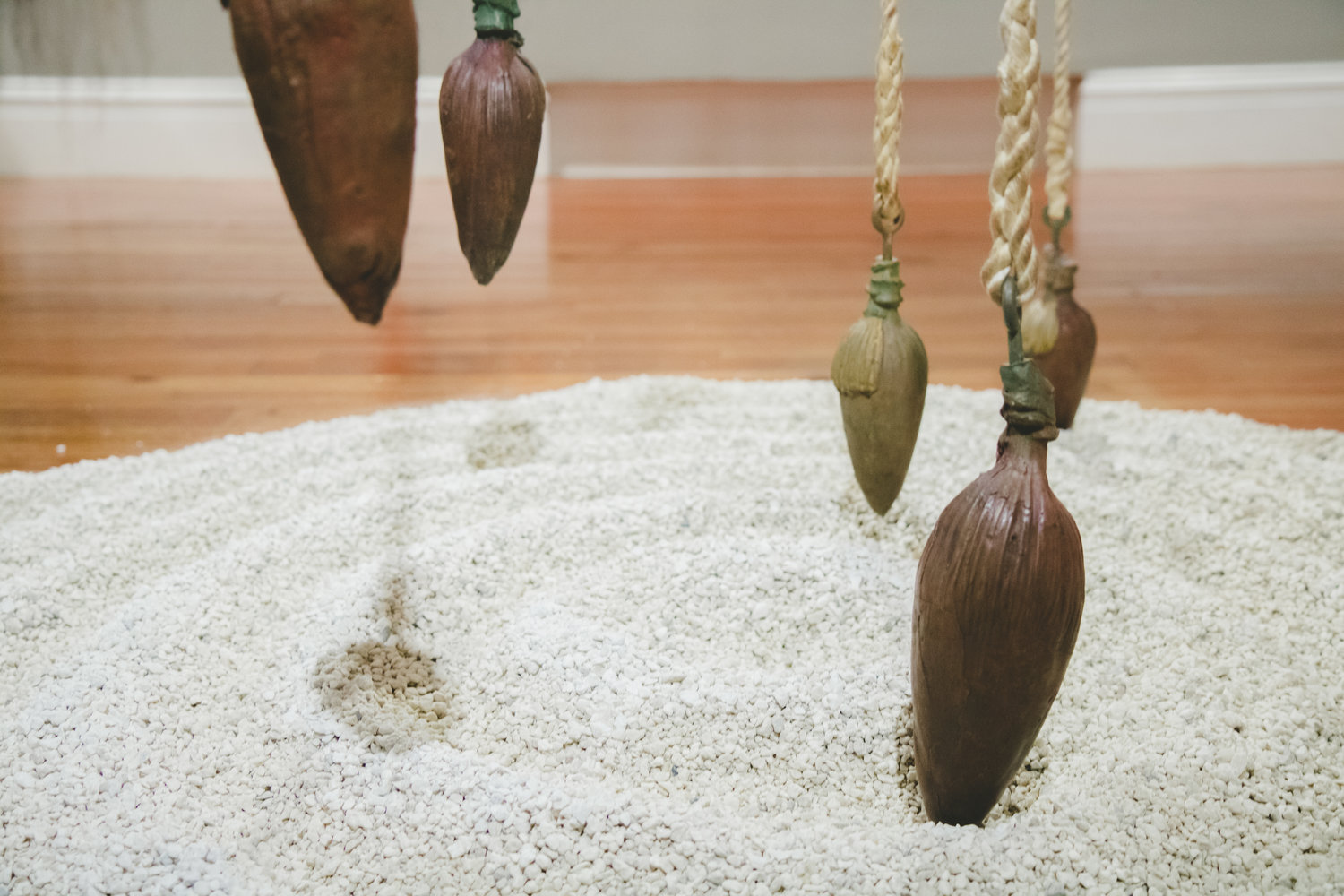A Botanical of Grief: Yasmin Glinton and Charlotte Henay Connect with Ancestors’ Voices and Put Mother Tongue to Poetry
Natalie Willis ●

In much of cultural studies, the Caribbean region has been discussed as a place where people feel an uneasy, tense tie to landscape due to our history of people being displaced here. Paradise or purgatory, whether these islands were viewed as restorative or a place of exile – and truthfully, we have had both stories ring true throughout time, it’s all in the branding. Tourist narratives aside, this space is a difficult one to feel truly close to, the landscape feels at once that it is ours and that it is without of our reach given the fact we are all “from elsewhere”, as Stuart Hall (the late Jamaican scholar and father of cultural studies) stated. Poetry in visual art can also be a difficult fit – is it language? Is it visual? Is it both? Problematizing our ties to the land and the neat boxes that traditionalists might wish to shove the vast world of poetry into, are the unapologetic works of Yasmin Glinton and Charlotte Henay.

A Botanical of Grief (2018), displayed in subtle silver script bearing powerful words of great weight, exists between – like so many of us in the Caribbean. The work is between voices: of the authors, of their ancestors, of poet and of artist, but it also exists in a liminal space physically as it spans the high walls of the stairwell of the 1860’s old bones that make up the Villa Doyle. Stairs are between places, and so are we as children of the Caribbean. We are between Africa and Europe, between India and China, we come from Arawaks, Tainos and Caribs with difficult access to those mother tongues – and most importantly, we are an amalgam of any and all combinations of these continents.
Angela Carter, English novelist, also put it into words quite poignantly:
“She herself is a haunted house. She does not possess herself; her ancestors sometimes come and peer out of the windows of her eyes and that is very frightening.”
The Bloody Chamber and Other Stories (1979)
The Caribbean is a melting pot, but it is also a landscape of the voices of millions of souls who came before speaking their truth in all manner of tongues.
We can also feel we exist between times, carrying our ancestors with us, bones “white and powdered” as the poets describe in heartbreak and, yes, in grief for those before us who we cannot access through text, artefact, through touch nor tongue. This botanical of grief is also a eulogy written in sand, water, and skeleton. It is also boldly matrilineal, an homage to the great-great-great-great grandmothers and beyond who lead to our particular shuffle in the deck of genes coming forward.
“Ancestry tests” such as 23-and-me, or those on ancestry.com, which use the matrilineal lineage of mitochondrial DNA (which, simply put, traces us down the lines of women who came before us – though of course in a very real, scientific kind of magic), are putting us at a rather interesting moment in considering the Caribbean. With the other potentially problematic implications of having your data (your actual DNA, the code that makes up the way you as an individual on this planet took shape), there is another problem that arises for people here: our ancestry is largely undocumented, and there have been mass migrations of other races and regions throughout our history. There isn’t a line to follow so much as a tangled web with missing links and newly forged connections. Glinton and Henay take these lines of flight and put them into form for us, through imagery and through broken lines we get the visual of what this lineage looks like. It is written performatively in its own way, the jarring spaces forcing us to concentrate and take pause to consider the weight of these womens’ voices.
“my grandmother left a plot of land when | she died i will never thank her for it i will plant the umbilical cord | of my children here hoping ⅓ of her blood is enough | for this earth to remember the weight of her feet | upon it.”
“I was born with silence – a clef | tongue within my mouth holding a garden of weeping, | a gift from my mother’s mother’s mother surrounded by | a seawall of rage built by her daughter”
“We can write it into becoming”
The poetry is umbilical, connecting to land and to our mothers, and indeed our “mother’s mothers”. The deference to the feminine familial line is to be admired in a space where we so often see women, and particularly Black women as the poets speak to, taken for granted. There is a significant part of each of us that forms in our grandmothers womb, when our mothers are in the fetal stage being developed there. Before our mothers enter the world in tears and blood and all manner of wild animal energy that reminds us we are indeed mammals, she is born with all the eggs she will ever have in her life – one of those very same eggs that gives the key X chromosome that makes us who we are. We are nurtured by our grandmother’s bodies before our father’s give their share. Our grandmothers help write us into becoming. They followed along from their own grandmothers, and theirs, and further along the chain still. The most incredible thing is that while we mightn’t be able to accurately trace where in Africa many of us in the Caribbean originate, we can trace back every human being that has ever lived to a single woman. This DNA we all share is commonly referred to as the “Eve Gene”, and reminds us of the way we are held by ancestors we couldn’t even possibly dream up.
We are all the same, but we all so inherently special to exist in this exact combination we cannot help but feel the magic of being a part of this universe. And so, to end on the words of the ever-relevant, ever-heartfelt, words of James Baldwin, never lacking in fervor: “I am what time, circumstance, history, have made of me, certainly, but I am, also, much more than that. So are we all.” (Notes of a Native Son, 1955).
Regardless of what we feel ties us to this place, regardless of new roots or old, we all share the same line and carve out our space.
The National Exhibition 9: The Fruit and the Seed will be on view at the NAGB through Sunday, April 7, 2019.
